Little Bo Peep has lost her Sheep and doesn’t know where to find them…..
It’s a good job that I’m here then.
 You search the hedges, I’ll look down the Mole hills.
You search the hedges, I’ll look down the Mole hills.
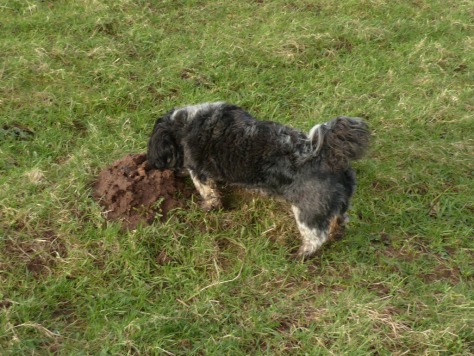 Shut up Fizz. She is not going to be down a Mole hill!
Shut up Fizz. She is not going to be down a Mole hill!
She might be.
 And so it goes on…. we lose our Sheep and then we find them. It is a good job that I have got such a clever tracking dog.
And so it goes on…. we lose our Sheep and then we find them. It is a good job that I have got such a clever tracking dog.
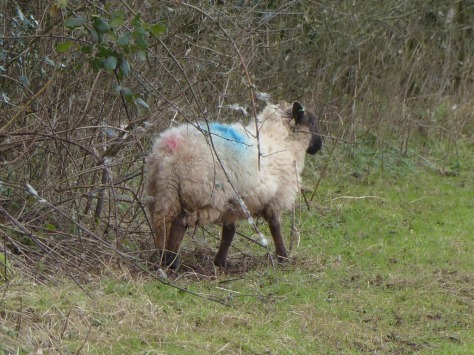 For anyone who hasn’t seen her in action here is a quick video demonstration of Fizz’s awesome search and retrieve skills.
For anyone who hasn’t seen her in action here is a quick video demonstration of Fizz’s awesome search and retrieve skills.
You just have to have faith, if you are lost then she will find you.
Well it rained all day today and I don’t have much to show you. This is one of my flower posts that I wrote yesterday.
Viola reichenbachiana, The Early Dog Violet
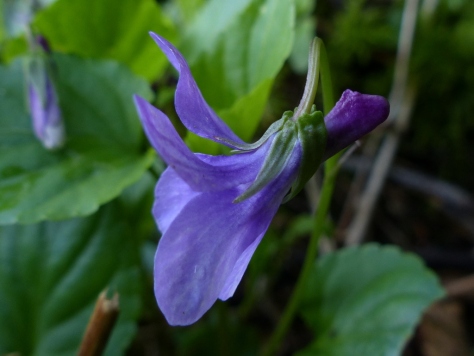 There are three little violet flowers called Dog Violets in the UK, they are the Early Dog Violet, The Common Dog Violet and the less common Heath Dog Violet. They can all hybridise and so telling them apart isn’t always easy but they do each have distinctive characteristics.
There are three little violet flowers called Dog Violets in the UK, they are the Early Dog Violet, The Common Dog Violet and the less common Heath Dog Violet. They can all hybridise and so telling them apart isn’t always easy but they do each have distinctive characteristics.
As it’s name suggests the Early Dog Violet flowers first, about three weeks before the common one. I took this next picture on March 16th and as you can see the flowers were already well established.
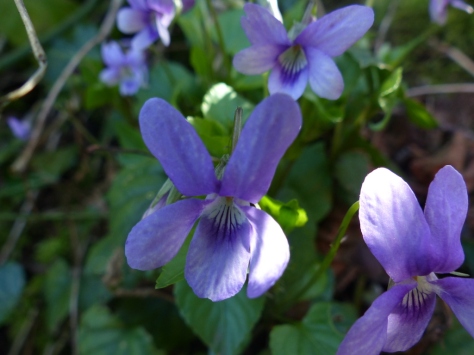 I didn’t see a Common Dog Violet last year until March 30th, so if you see a Dog Violet early in March it is probably this one but you don’t have to guess.
I didn’t see a Common Dog Violet last year until March 30th, so if you see a Dog Violet early in March it is probably this one but you don’t have to guess.
The Dog Violet has a spur behind the flower and with the other two species the spur is lighter than the petals. The Spur on the Early Dog Violet is darker than the petals.
 For comparison this next picture is a Common Dog Violet with a much lighter spur and the Heath Dog Violet is also lighter and quite yellow.
For comparison this next picture is a Common Dog Violet with a much lighter spur and the Heath Dog Violet is also lighter and quite yellow.
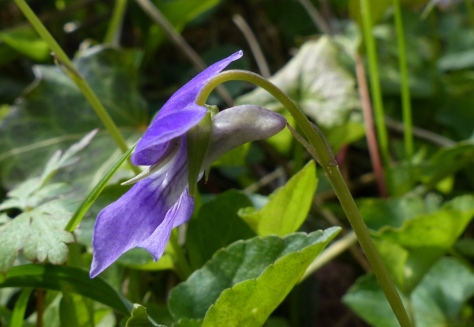 The other easy to spot difference is with the markings on the lower petal. These lines serve to direct insects to the nectar and they are much less pronounced on the Early Dog Violet.
The other easy to spot difference is with the markings on the lower petal. These lines serve to direct insects to the nectar and they are much less pronounced on the Early Dog Violet.
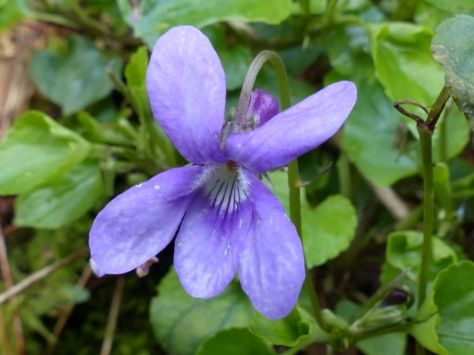 Again for comparison this next picture is a Common Dog Violet, The Heath Dog Violet is vividly marked like this too.
Again for comparison this next picture is a Common Dog Violet, The Heath Dog Violet is vividly marked like this too.
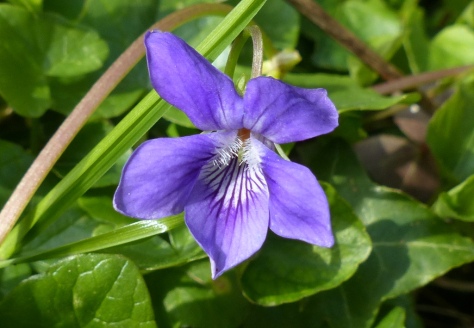 Okay the difference is relative and not always easy to spot if you don’t have another flower to compare with but bright, intense markings would immediately make me look at the spur.
Okay the difference is relative and not always easy to spot if you don’t have another flower to compare with but bright, intense markings would immediately make me look at the spur.
The Early Dog Violet, Viola reichenbachiana.
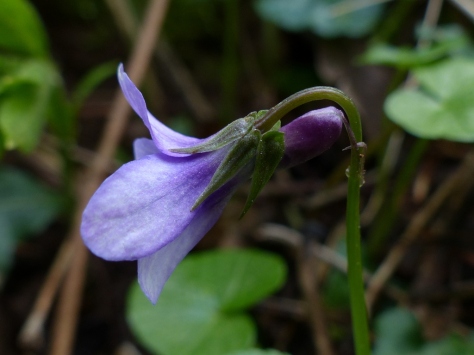 V. reichenbachiana is a bit of a mouthful. It is named after a German Botanist, Heinrich Gustav Reichenbach, who specialised in Orchids. He has actually got about a dozen different flowers named after him but someone must have felt that he needed a Violet.
V. reichenbachiana is a bit of a mouthful. It is named after a German Botanist, Heinrich Gustav Reichenbach, who specialised in Orchids. He has actually got about a dozen different flowers named after him but someone must have felt that he needed a Violet.
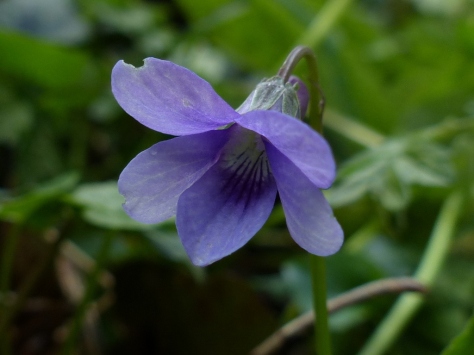 Violets have a complicated reproductive strategy that isn’t really relevant to identifying the flower but it still makes for an interesting read. The best explanation that I have found on the web is here.
Violets have a complicated reproductive strategy that isn’t really relevant to identifying the flower but it still makes for an interesting read. The best explanation that I have found on the web is here.
http://cronodon.com/BioTech/violaceae.html
That article goes some way to explaining why the inside of a violet looks like this.
 Basically the Violet has two different types of flower. The open flowers that we are familiar with are specially designed to achieve cross pollination.
Basically the Violet has two different types of flower. The open flowers that we are familiar with are specially designed to achieve cross pollination.
 Violets are hermaphrodite and capable of self fertilisation but the open flowers are carefully designed to avoid that, however the majority of seed produced is self pollinated. To achieve this the Violet produces another sort of flower. These are small flowers that will never open, they are self fertile. They appear as the plant matures and they are actually responsible for most of the seed production.
Violets are hermaphrodite and capable of self fertilisation but the open flowers are carefully designed to avoid that, however the majority of seed produced is self pollinated. To achieve this the Violet produces another sort of flower. These are small flowers that will never open, they are self fertile. They appear as the plant matures and they are actually responsible for most of the seed production.
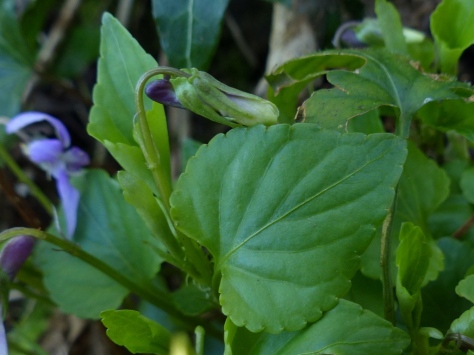 The plant seems to go to a lot of trouble to try and cross pollinate when it doesn’t really have to but it is thought that even a small amount of cross pollination benefits the gene pool.
The plant seems to go to a lot of trouble to try and cross pollinate when it doesn’t really have to but it is thought that even a small amount of cross pollination benefits the gene pool.
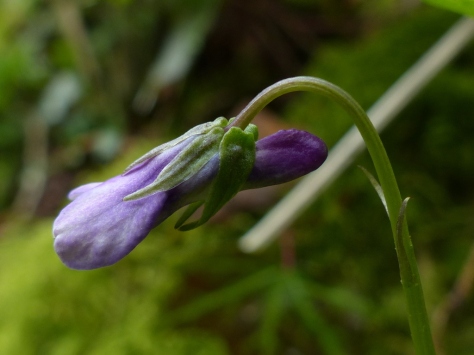 Early Dog Violet has a long stem bearing a single flower.
Early Dog Violet has a long stem bearing a single flower.
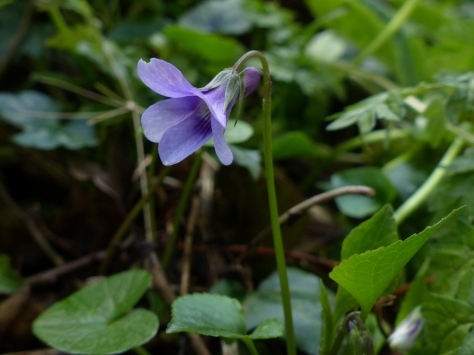 The leaves are heart shaped with finely scalloped edges.
The leaves are heart shaped with finely scalloped edges.

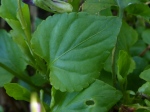
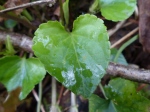
 It grows in shady woodlands, hedgerows and coppice. It is native to the UK, more common in the South and almost absent from Scotland.
It grows in shady woodlands, hedgerows and coppice. It is native to the UK, more common in the South and almost absent from Scotland.
Kingdom: Plantae
Order: Malpighiales
Family: Violaceae
Genus: Viola
Species: Viola reichenbachiana
I am sorry that there wasn’t more to this post today but it was just a very dull day at the office. Tomorrow we are going to resume our Big Game Hunting and maybe film a Troll 🙂

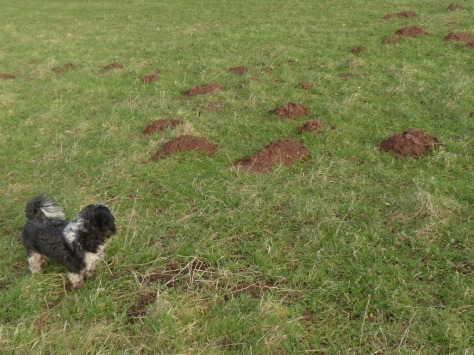
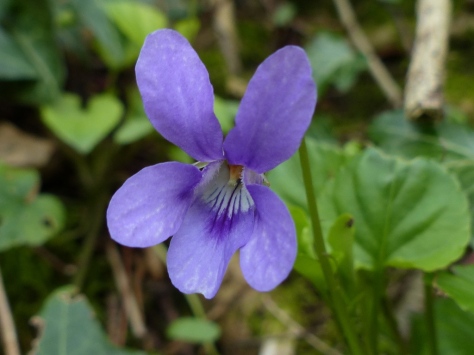
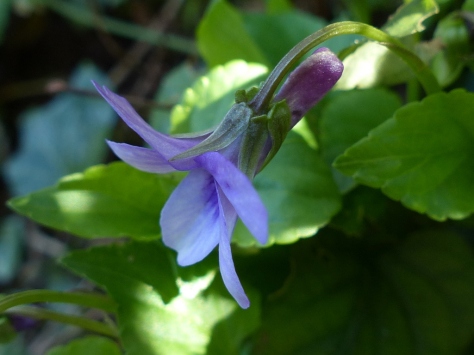
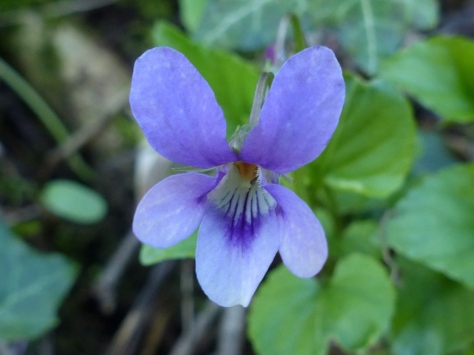
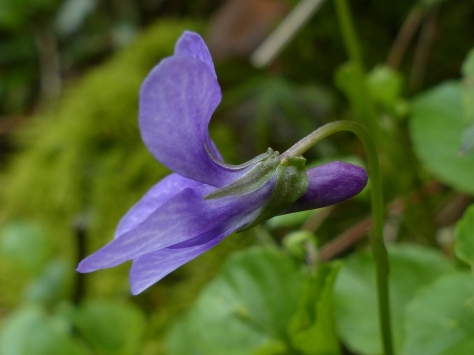
each time I look at Fizz I think of my grandmother, she somehow looks like her… this is really not normal, right? hahahaha
LikeLike
Your grandmother must be a real cutie.
LikeLiked by 1 person
She is! 🙂
LikeLiked by 1 person
Thank you Becky 🙂 Big eyes, a sweet face and a wisp of grey hair?
LikeLiked by 1 person
Excactly, and those funny faces on photos 😀
LikeLike
I reckon Fizz knew where that ball was all along, she was just messing with you 🙂
LikeLike
Thank you Emily 🙂 She seems to enjoy looking for it more than she enjoys actually finding it.
LikeLike
Aha! Success at last. Imagine how very huge the world must seem to her….galloping as she does through the tall grass. I loved the video
LikeLike
Thank you Barbara 🙂 She is really very brave, pushing through a jungle of tall grass with no idea of what might be ahead of her. It is a wonder that she can find anything.
LikeLike
A troll, that will be a good thing. Tell Fizz she’s so cute that she should be in the movies. Love the violets; such delicate little flowers.
LikeLike
Thank you Sarasin 🙂 It is always fascinating to see what is wandering around the forest at night.
LikeLiked by 1 person
Obviously the early dog violet knows it doesn’t have as much competition… Fizz’s tracking skills are miraculous 🙂
LikeLike
Thank you Maureen 🙂 Yes, it is a miracle that she ever finds anything 🙂
LikeLiked by 1 person
Your posts are always great! Happy Trails!
LikeLike
Thank you Sandi 🙂
LikeLiked by 1 person
Happy Trails!!
LikeLike
The video was fun. I think she knew where it was, but she just wanted to be on film longer.
LikeLike
Thank you Dan 🙂 She enjoys the game of searching for the ball.
LikeLike
The video made me laugh! Fizz is no Shrinking Dog Violet. I liked the dog violet info and the photos are superb as always.
LikeLike
Thank you Clare 🙂
LikeLike
Fizz isn’t retired sniffer dog then? Are dogs like birds? For example Curlews and Godwits “hunt” by touch, poking their bill deep into the mud, whereas Plover tend to look stupid, but are actually diligently searching by eye. All I know about dogs can be written on one short blog post.
LikeLike
Thank you Stephen 🙂 All of the other dogs that I have known watch where the ball is going and then close in on it by nose. Fizz tries but there is a lot of luck involved and it is a good idea for me to keep an eye on where the ball has gone. We lose a lot of balls.
LikeLike
apologies, I should have checked my comment before posting – many typos. Sorry
LikeLike
This is very informative. 🙂
LikeLike
Thank you Imelda 🙂
LikeLike
HO ho Fizz…. Loved the video… And good info on violets
LikeLike
Thank you Michelle 🙂
LikeLike
Do you think Fizz’s nose is compromised because of her being short-nosed (brachycephalic)? She seems to take it in stride!
I love your explanations of violets – you make it easy to see the differences. My lawn is covered with dog violets every May and I hold off mowing just so I can enjoy them.
LikeLike
Thank you Eliza 🙂 Yes exactly and we shouldn’t laugh at her, she does her best. Her vision is also pretty compromised with hair all over her face and only being a few inches tall doesn’t help. She has been bred as a Toy Dog or Companion animal and her main attribute is cuteness, it is not her fault that man messed about with the Wolf. As it happens she was the only applicant that I got when I advertised for a Nature Detective Dog and as I was the only one to apply for her post of Pirate we decided that we were stuck with each other. She is very intelligent. Who else would think of looking for a Sheep in a Mole hill? 🙂
LikeLiked by 1 person
LOL – beyond cuteness!
LikeLike
Clever Fizz, with all eyes on her for the video.
LikeLike
Thank you Peggy 🙂
LikeLike
I wonder if these little Dog Violets are the same as the ‘Johnny Jump-Ups’ that would self seed and spread all over my flower beds… such sweet little flowers.
LikeLike
Thanks Joy 🙂 If not the same then they are probably a close relative. There are a few Viola species given the name Johnny Jump Up in the US. This one tends to grow in woodland and likes a bit of shade.
LikeLike
Ah that old Joe Cocker song, “I’ll find the ball with a little help from my friends”. It strikes me as very reasonable to look down mole hills for sheep. Sheep are incredibly devious. I’m on Fizz’s side.
LikeLike
Thank you Andrew 🙂 She thinks outside of the box. She did once find a Mole.
LikeLiked by 1 person
The ultra violets are doggedly flowerescent 😉
Fizz as always is just effervescent. ❤
Alas the sheep keep the pain in your neck ever present 😦
But despite those bleating hearts your blog is resplendent. 🙂
I'm really sorry but your posts bring out the verse in me.
LikeLike
Thank you Stephanie 🙂 The Sheep are going to be locked up for a bit. The farmer is going on holiday, I am in charge and the Sheep will live in the orchard. Fizz and I get a week off, next week and I like your verse 🙂
LikeLike
This made me smile! Thank you sir! What a clever little dog. Love violets and these are very elegant.
LikeLike
Thank you Kim 🙂 She is a clever little dog.
LikeLiked by 1 person
I am drinking up your violet photos. They will help me get through January. Thanks!
LikeLike
Thank you Lora 🙂 Focusing on the flowers that will soon be here is helping me through the winter too 🙂
LikeLike
Nice . . .
Figured out the issue with the subscription. Turns out I had modified the filter to archive your posts while I was traveling, and forgot to set it back. Sorry.
LikeLike
Thank you Emilio 🙂 Glad everything is sorted.
LikeLike
Seeing the beauty of these flowers has made it clear to me why Violet was such a popular name for girls at various periods in our histories. A lovely namesake indeed.
LikeLike
Thank you David 🙂 Girls seem to have collared all the pretty names.
LikeLike
Your photographs are beautiful and your walks in the woods are so instropsective and poetic, somehow!. Thanks for sharing. All the best to you, Aquileana 😀
LikeLike
Thank you Aquileana 🙂 My little reality bites cannot compare to your beautiful mythology.
LikeLike
Did you paint little Bo peep? She matches the flowers! I love it!
LikeLike
Thank You 🙂 Every time the Sheep get a treatment they get a different splash of paint. A red stripe on the head means this one was wormed in January, that sort of thing. So we have very colourful Sheep and nobody can remember why.
LikeLike
I see you’ve visiting my blog again. I appreciate your time. I enjoyed the post. You have some wonderful photos here. 🙂
LikeLike
Thank you Natalie 🙂
LikeLiked by 1 person